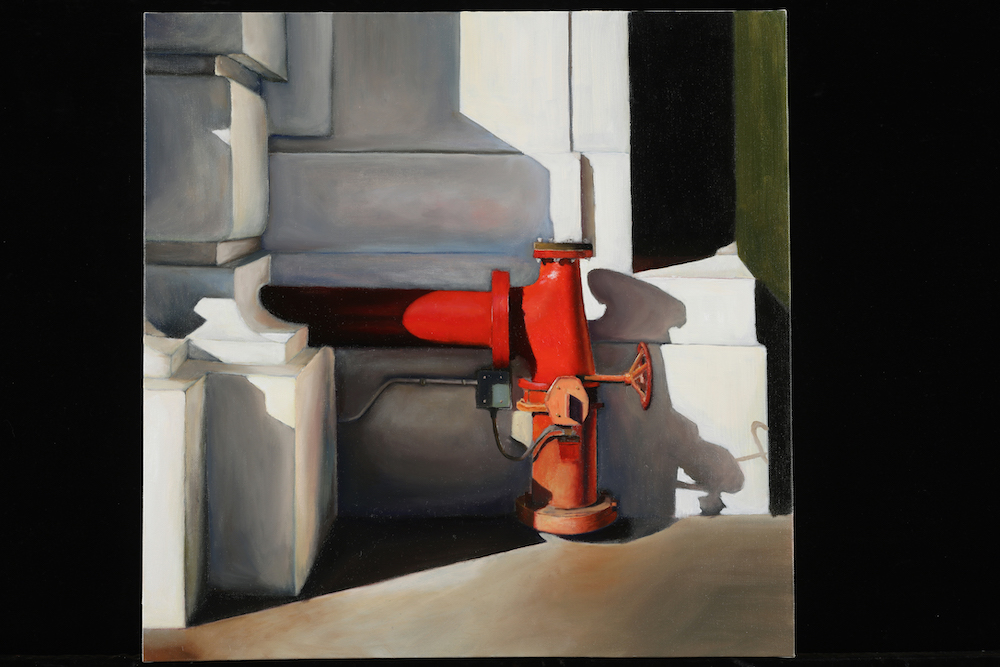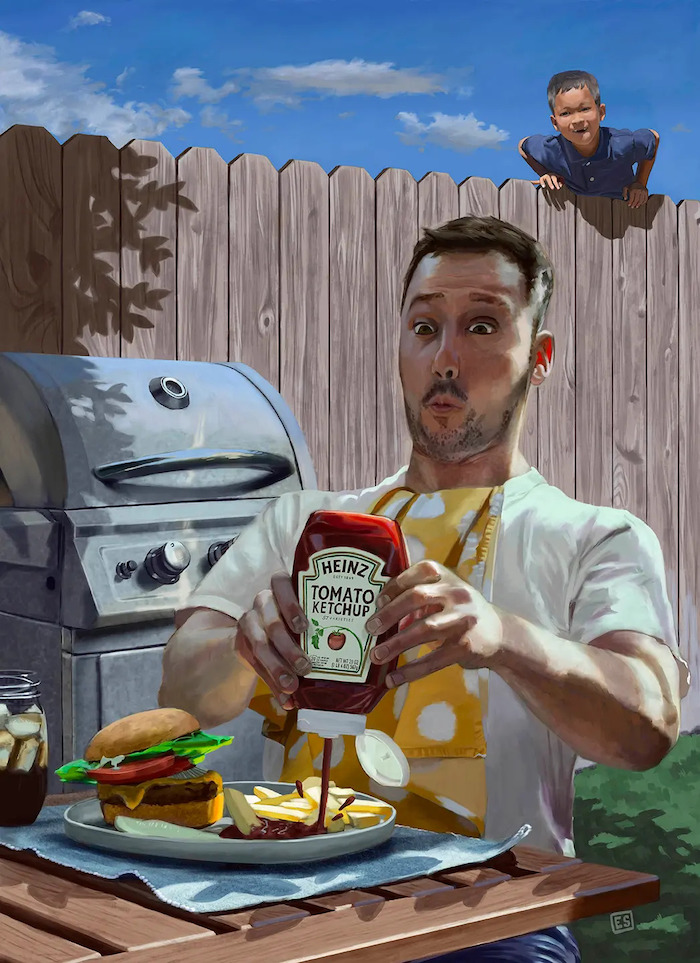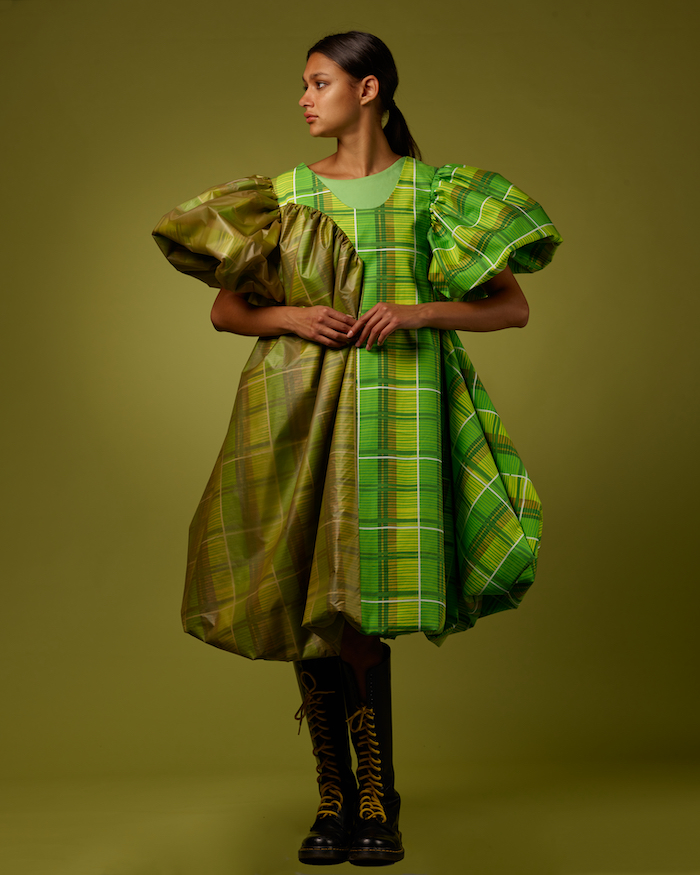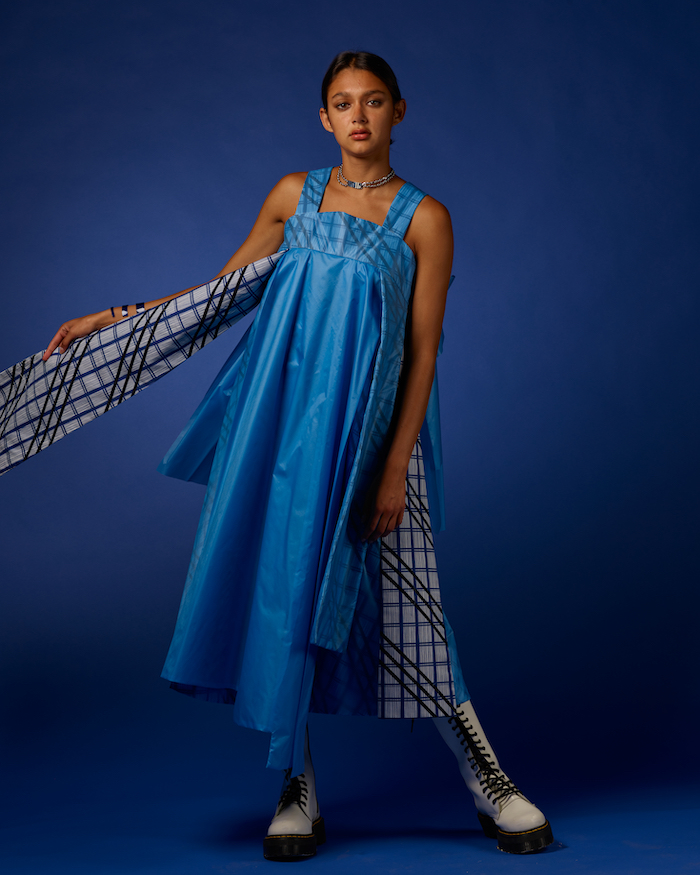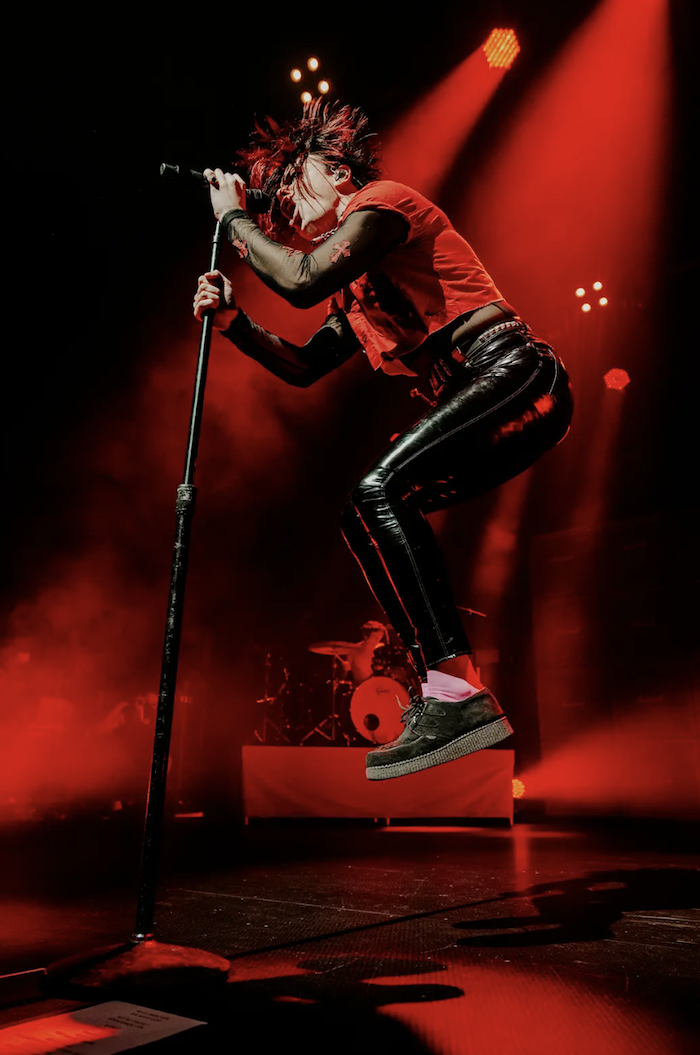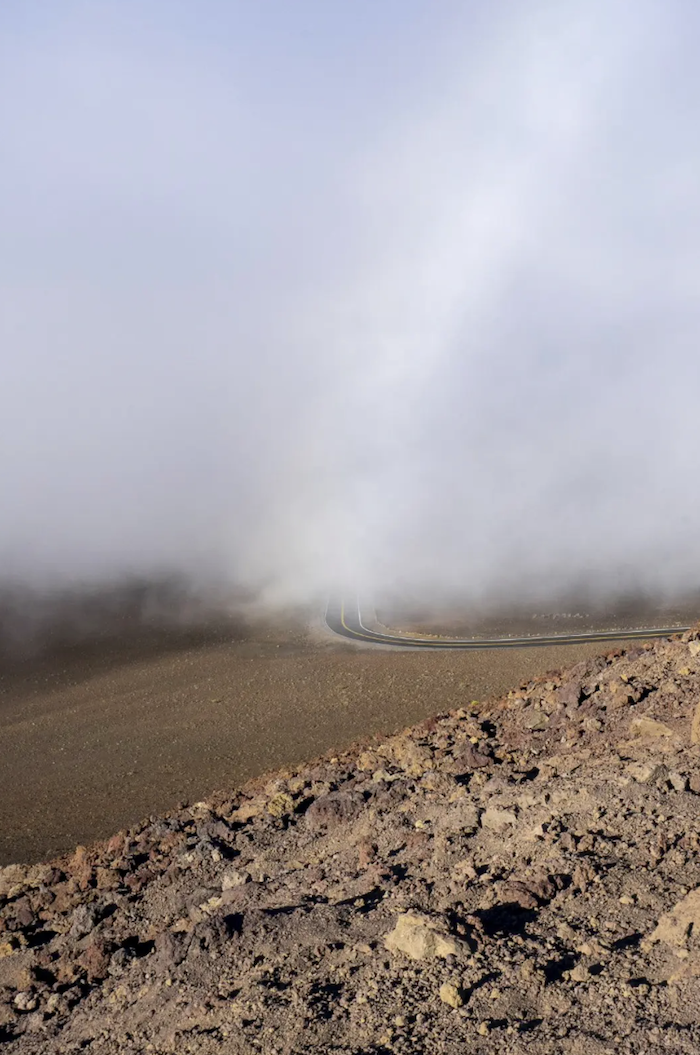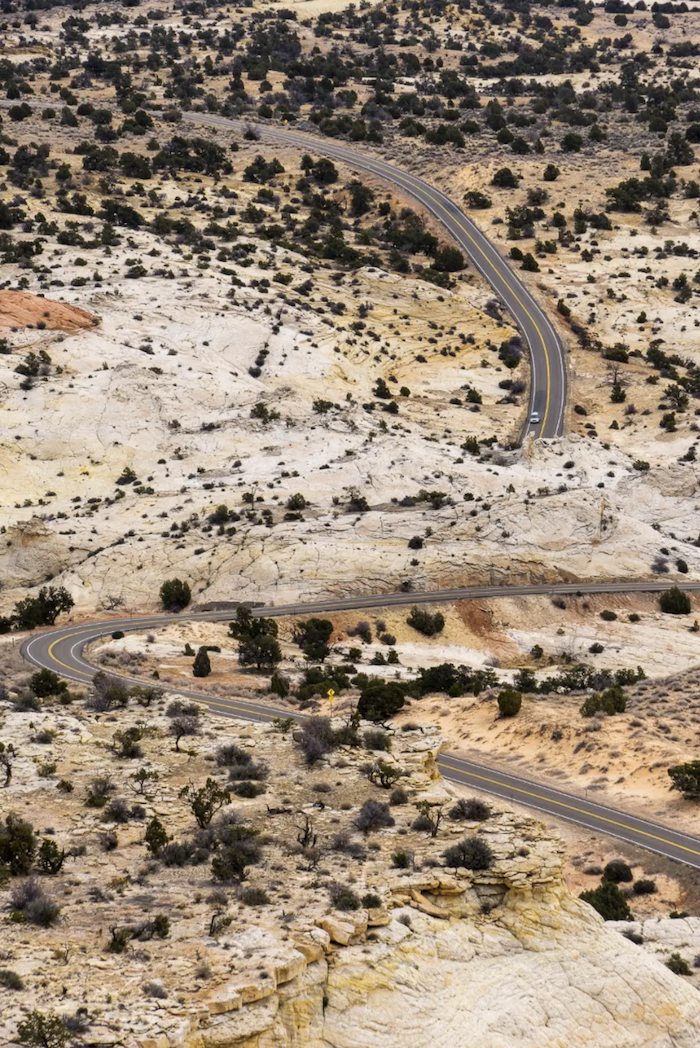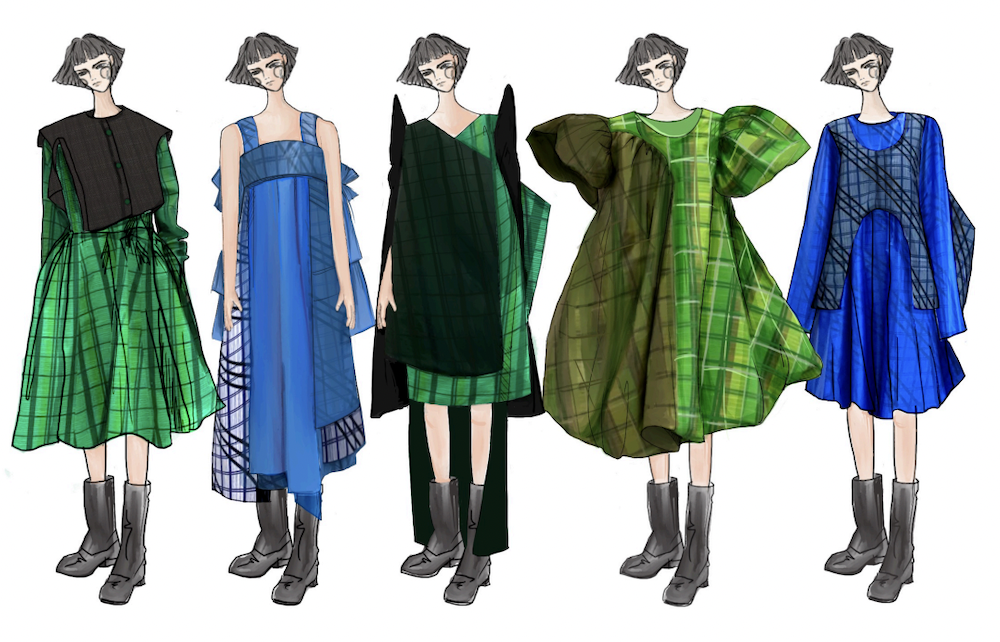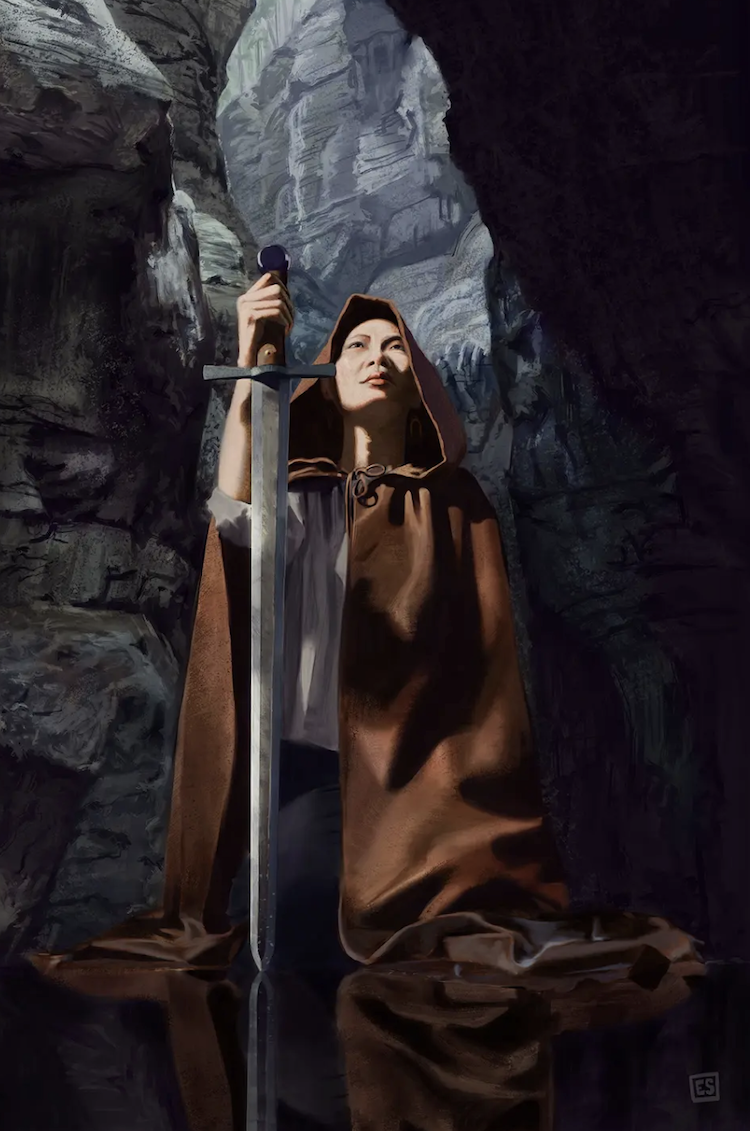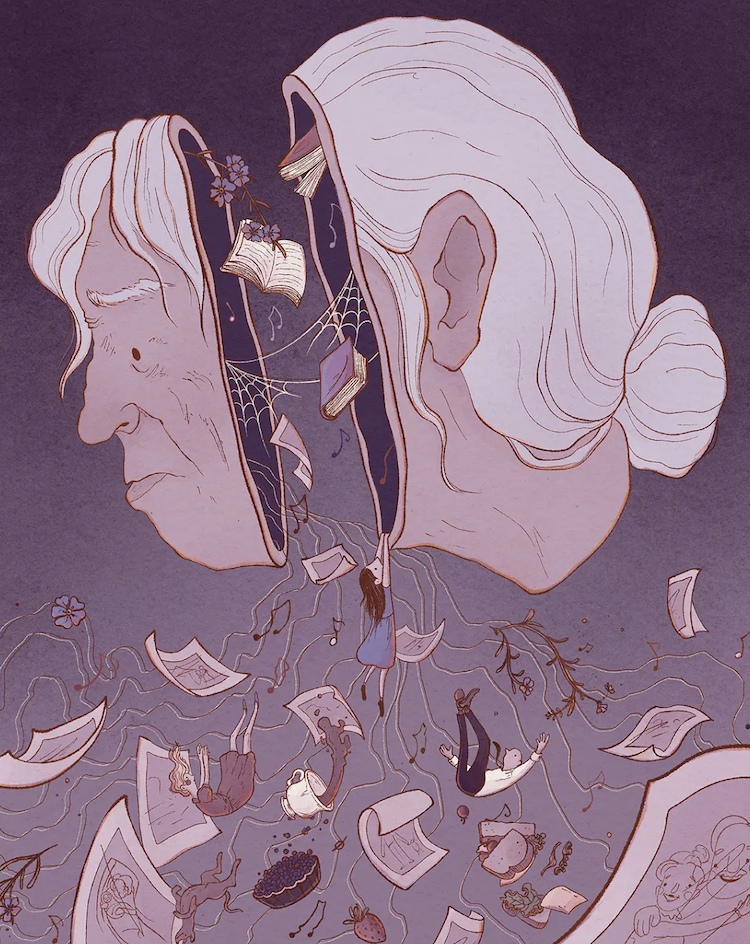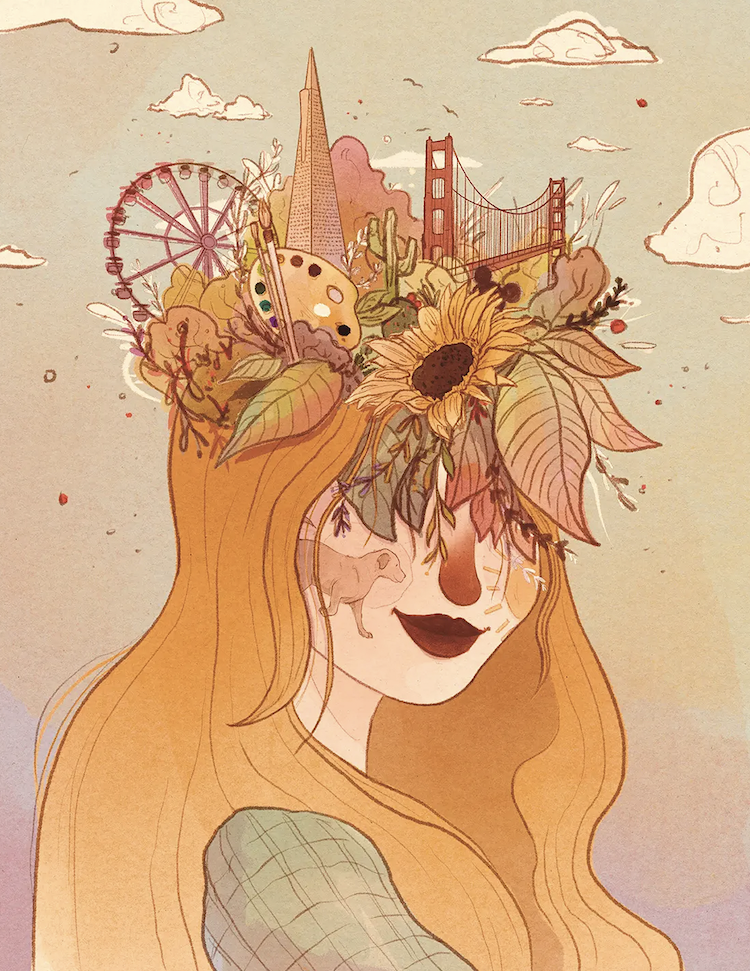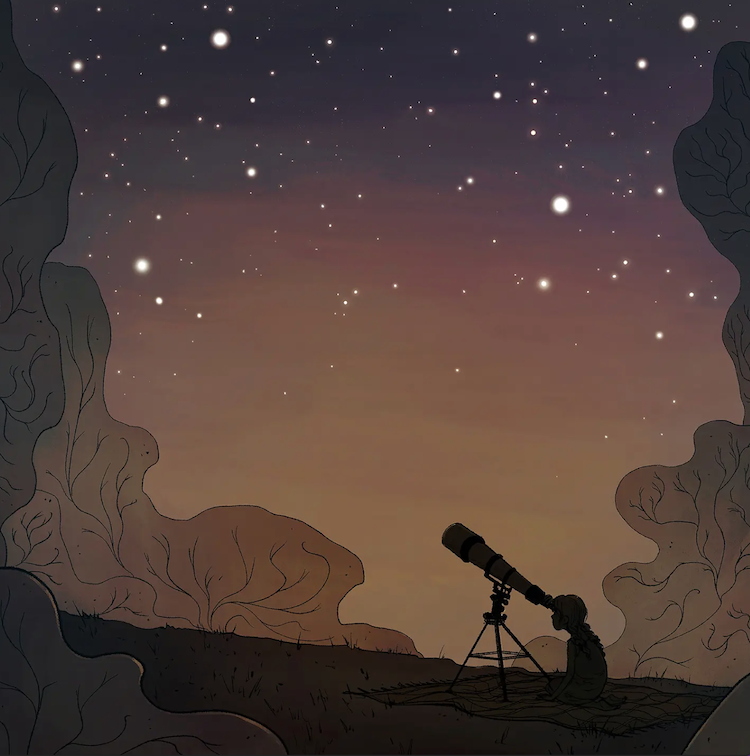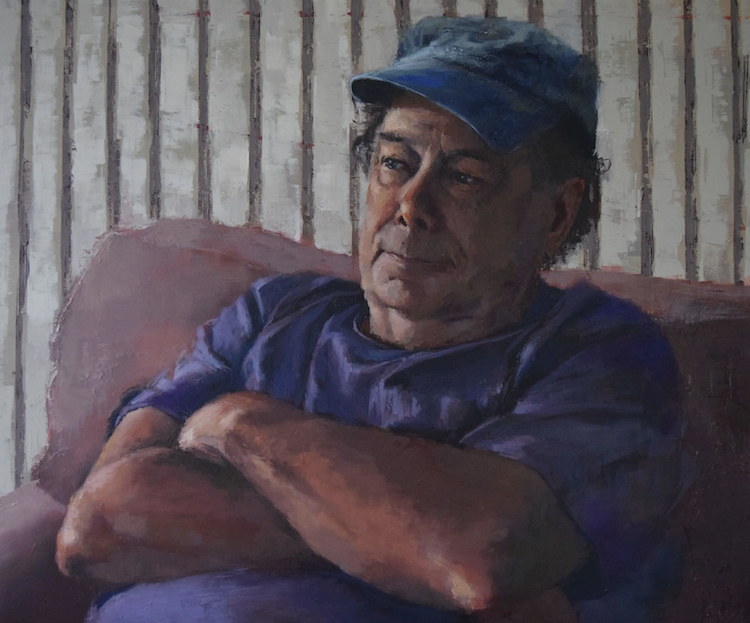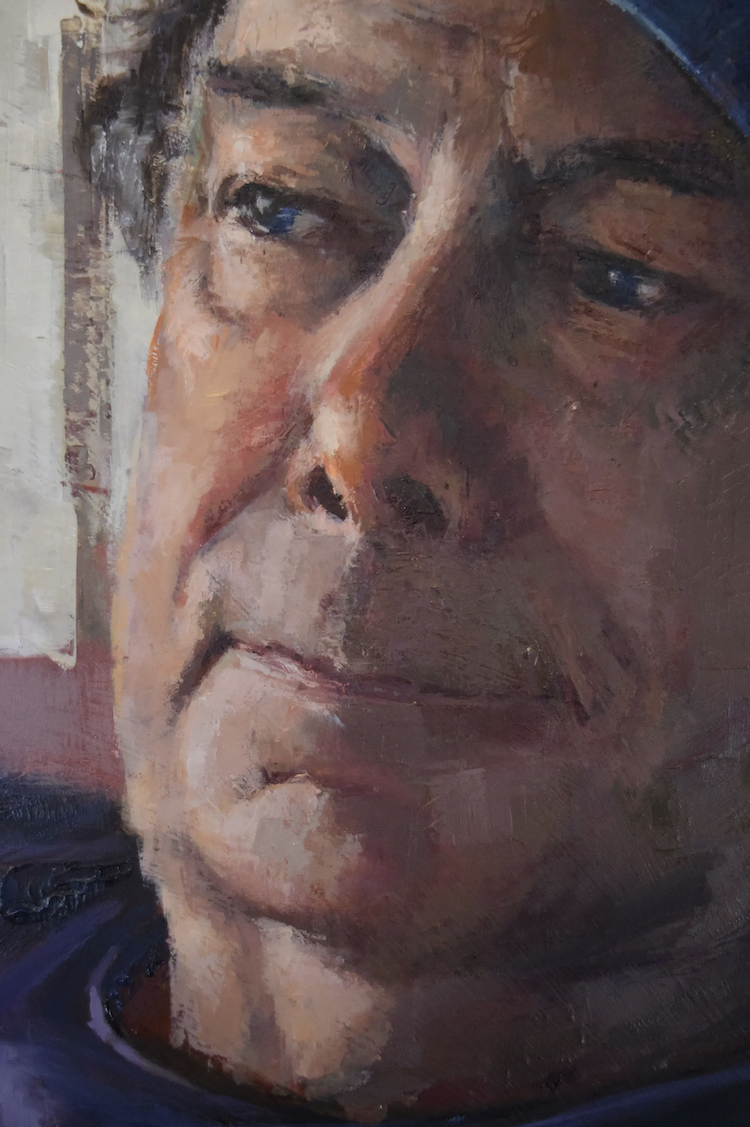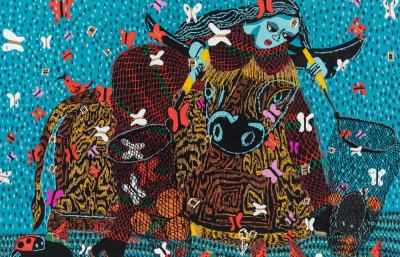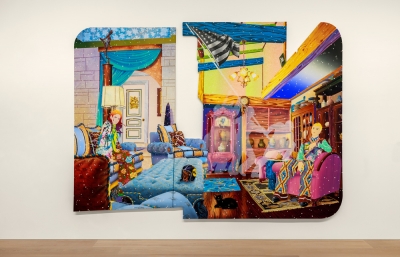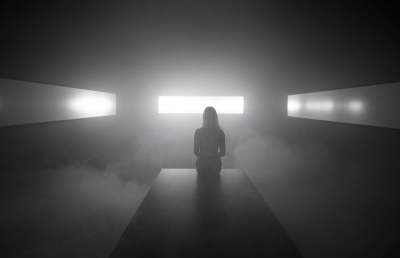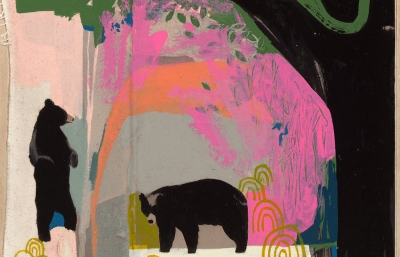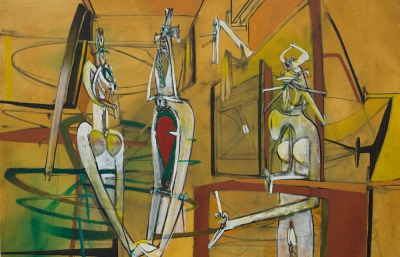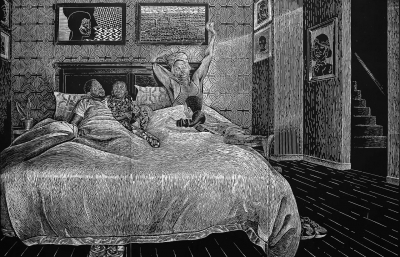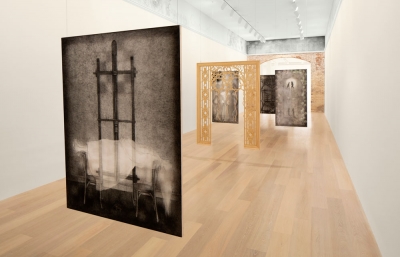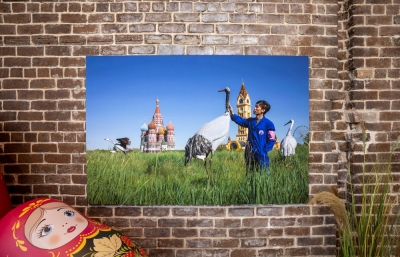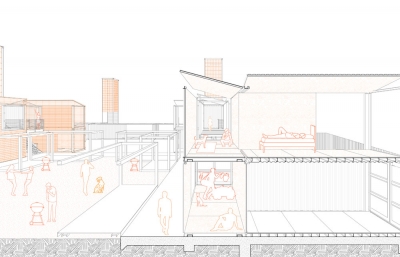Entering the Academy of Art University's Spring Show is like hungrily appraising a beautiful buffet, approaching the blind tasting, ready to relish the familiar and comforting, but also curious about the exotic or unfamiliar. It’s an international smorgasboard, described by the school as a Global View of Student Portfolios. Although I had the honor of visiting in person (where there happened to be a delicious buffet lunch), the final projects are available online for everyone’s visual snacking. However, as I invite you to follow along and savor my personal favorites, I hope you’ll enjoy learning about the inspirations for these offerings, as well as appreciate how this truly does boast global reach. After approaching several student/artists for some background, I was surprised to learn that two of them are from New Zealand, one born in inner Mongolia and another from Poland. We have so much in common and so much to learn from each other. Enjoy!

Raw, red and black! Raw, red, black and leaping forward, guitar as much weapon as shield. Justine Willard’s portrayal of H.E.R. at the forefront of a stage, thighs strong as her fingers wielding the guitar strings. The photo commands Stop like a traffic sign. Justine admits to taking guitar and drum lessons growing up, and even tried teaching herself piano, “but I never stuck with them enough.” Then came one lazy summer when “My older brother gave me his old camera and my mom signed me up for a summer photography class at the Academy that is free for highschoolers and I just fell in love with it.”
Justine’s photographs are full of color and physicality, punching as much weight as video. When I asked how she approaches her subjects, she spoke with strategic confidence, “When shooting concerts, you never know what’s going to happen, so you have to pay attention and trust that you can get the shot. I also shoot a lot of flm, as well, so just being able to play around with different mediums I can always get something different even if the subject matter is the same.” Naturally, after being baptized at summer school and being a Bay Area native, the Academy of Art was an easy choice, although she appreciates how “All the teachers understood that I was passionate about concert photography, and even though it was different from what the others were doing, they still let me do it for my final project.”
As for the shot of H.E.R. at the Concord Pavillion, “I was standing at the end of the catwalk and she just started walking down and kneeled right in front of me. I held down my shutter button and took as many pictures as I could and when I saw the fireworks go off behind her while looking through my viewfinder, I knew that was the shot.”

While Willard’s red leather jacketed subjects brandish microphones in crowded clubs that haven’t seen the light of day, Zack Harper’s alternating overcast and Downey blue skies are “from a high vantage point from inside my van. Having such a spacious vehicle I can fully slide open the door and set up my tripod inside.” But in the Way Back, Zack wasn’t one of those kids doodling and sketching. ‘I was never gifted with an artistic hand, I always found my creative outlet digitally or through technology. Small projects here and there but mostly driven by a curiosity to learn new skills … and when I got my first cheap DSLR.this was the best outletI had found to create away from my computer. Harper discovered how videography is much more labor intensive in post production and found himself prioritizing photo subjects over video, “I am more free to choose the style and process I want to work in. I can use a century old camera , working in a decade 9od process, emulating the style of any past artist. Like my exploration of the country and its roads, I can just wander and get lost in my own creativity,”
Maybe piqued by the draw of mystery, the elements of wondering and wandering absolutely drew me to his work that dictates the scene. As opposed to portraiture, his Road to Somewhere speaks to a living and changing landscape “A guided tour of my explorations that present to the viewer the importance of the journey, the photographs, like the road, transporting us, promising freedom and the unknown.” Referencing Alec Soth and his project Sleeping Along the Mississippi, “I resist definition of my photography … I can shoot whatever I want in a serendipitous way, shoot portraits, landscapes and still lifes and mix it all together under a single concept.” And in summarizing another influence, Todd Hido (shout out, Pacifica!) there’s the mantra, “Sometimes the reason you’re working on something only makes sense to you years later.”
Viewing the photographs, Willard’s smack with a heart-stopping tension, and Harper’s invite a quieter introspection where beiges blur and the bright greens variegate. In describing process, he values working things out in his head, particularly on a drive. “It is a perfect mix of muscle memory, instinct and awareness, where you can almost switch your conscious mind away and put it on auto-pilot. I’ve heard it called “the shower principles”, the moment of inspiration when the brain is distracted from the problem at hand. And what about feedback from professors and fellow students? “I’ll definitely miss having a weekly audience for feedback, to get their thoughts from an artistic point of view with high visual literacy. The only issue was that everyone was so supportive .. but there are definitely worse problems to have ha ha.”


I wish I could have been in the audience for the Academy’s end of the year fashion graduate school, an especially joyous occasion for the students who had graduated during Covid lockdown, and were able to applaud the announcement of British designer Giles Deacon who was presented with an honorary doctorate by AAU President Elisa Stephens. Not only has Deacon worked with the houses of Bottega Venetta, Gucci, Tom Ford and Ungaro, he collaborated with the Cadbury Caramel Bunny. He also designed the wedding dress of Pippa Middleton, hence my segue into the locale of the show, St. Brigid’s church, a survivor of San Francisco’s 1906 earthquake, a stone and stained glass beauty. With a choral performance and musical variety as representative as the models, the video captured the moods, contours and textures of modern fashion.
Many samples from the ceremony were on display at the Spring Show, but a particular designer floated forward like some colorful hot air balloon. The fashions of Yuli Lee illuminated the church with a brilliant use of color and flowing fabric that reflected the glass, appearing like modern-day vestments. Formed around mannequins at the exhibit the clothes radiated bright confidence and comfortable, but structured silhouettes.
Yuli echoed by thoughts. “I want to design clothes that can be continuous and free, clothes that can capture individuality regardless of any style” Not only does her practice involve drawing, which she studied before fashion, but also from daily life. “If there is an impressive scene on the street, I take a picture right away and use it for my next design topic. I get my ideas in my daily life, so I write them in notes before I forget, so my notes are full of pure ideas that aren’t trimmed. In fact, my thesis came from my notes. As I was walking along the street, my shadow in the sunlight was seen as a boundary line, and I was impressed at how the silhouette changed according to my movement!” Yuli feels she really tapped into her visions through school, “where I learned my inherent creativity … I think the process of fashion design is to bring out the artistry within us.”

Are illustrators the people pleasers, maybe the fun people? Noting the physicality in Eric Seaburg’s work, I wondered if he was an outdoors enthusiast, to which he answered, “I do love the outdoors, and enjoy many hobbies including horseback riding, fishing, hiking, mountain climbing, camping and other activities.” Or maybe it’s growing up in New Zealand, where he took his first art classes and cites his inspirational art teacher and where “Our first assignment was to draw circles, cones and spheres with giant black and white crayons on gray toned paper. Years later, Academy of Art became his school of choice, an experience that he cites as developing his style. “All the teachers really pour their heart into teaching art skills which is not an easy task. “There are so many great ones, teachers like Christopher Canga and Stephen Player” whose class taught him how to craft a realistic scene using accurate and well-thought out perspective.”
Although Seaburg’s work is full of action and humor, derived, as he says “from my love of fantasy, science fiction, mystery, thriller genres, movies and comic books, it is grounded in a profound respect for the classic illustrators, among them Norman Rockwwll, as well as a distinct personal understanding of the role of illustration. “My process is a time honored one that usually starts with sketches and research, followed by reference photos. There are many steps, and honestly, more time is put into the initial research stages than painting the final piece. I will always have a deadline that seems shorter than I need, but my job is to create the art in whatever period is needed. I can dream of all kinds of crazy scenes, and hopefully, will one day. I’m currently working on a book cover and my job as an illustrator is to make their dream come true.”
And while Seaburg also cited the Walking Dead comic books, his first inspiration was the New Zealand abstract artist Gordon Walters (“Look him up, he was a great designer and artist!”) who was fascinated by the geometric spiral form of the koru and fused modernism with traditional Maori art. Yep, illustrators can surprise you!

But yes, behind every good illustrator, there lurks Garfield and Donald Duck! “I was obsessed with them. I ran to the store whenever there was a new issue that got published in Poland, and I would constantly reread them while eating my cereal, on my way to school and back. Garfield even inspired me to come up with my own hand drawn magazine about cats.” Magdalena Metrycka’s parents took her to galleries and museums as a young girl, and she admits to reaching back for inspiration from those times. While dreams as disparate as orca training and filmmaking filled childhood dreams, social anxiety and bouts of depression plagued teen-age years. “I turned to drawing and painting during that time, and that really helped me get through it. Art was what felt right, so I decided to go with it.”
“I got to visit the Academy of Art University before I applied, and I absolutely loved the student work I saw on the walls of the Illustration building and the clothed figure drawing class I got to see. I still remember the model, who was an older woman with silver hair, dressed in a milkmaid costume. There was classical music playing, and a small circle of students around her, drawing on big pads with charcoal. That’s what made me choose this school, and I was not disappointed.”
Rosy cheeked bears and, of course, cats, populate the whimsy and comforting fairytale elements of Magdalena’s work, lending themselves to her goals of writing childrens’ books and graphic novels, or possibly working in animation or video. Characters are her favorite thing to draw, and, like Seaburg she agrees that the prep work of a semi-formed idea and the repetition of many sketches before arriving at a polished illustration can be the biggest challenge.
While the whimsy of pumpkin trains and starry blue nights is the stuff of dreams, the old woman presents a whole different scenario. “Last semester I took a class called Editorial Illustration and had a wonderful teacher, Jorge Mascarenhas, who pushed us to think outside the box and not be afraid of the prompts he was giving us. The prompt behind this drawing was Alzheimre’s disease. I wanted the illustration to be obvious in terms of representation, but wanted to go a little surrealistic. The things falling out of the old woman’s head are her memories, people, songs, books, tastes and other things she is starting to forget. My most poignant element is the girl who’s hanging down, trying to hold onto the head and not be forgotten.” An illustration that speaks to us all.

A common thread shared by all the student/artists is the lifelong identification of being a maker. Laurie Roodt explains that she began dabbling with water colors 30 years ago, moved on to oils, then realized that, “Above all else, I need proper teaching. I hoped that art school would equip me with the tools needed to reconcile the pictures in my mind. AAU more than delivered! The depth of relentless pursuit of mastering the basics impressed me, and now at the end of my time at the Academy, I’m deeply grateful. The teachers are fully invested in each student, and I was surprised by the extent to which they provide all that is needed for their students to succeed. I live at the ends of the earth in New Zealand; however, interaction within the virtual class was always lively and inspirational and we always fed off each other.”
Laurie is captivated by portraiture, becoming so involved in the only activity that causes her to forget to eat! Bone structure, posture, and perceived expressions all provide her appreciation of honoring each person’s worth, of telling their story. Photography is an essential tool in the process, specifically a visit to the subject’s home. Black and white photos serve as reference, followed by her own color choices, accompanied by sketching and more sketching, as she integrates geometry (“I’m quite mathematically minded”) into composition and anatomical structure. And when it’s time for paint application, she’s “graduated” to aluminum. “One of my AAU instructors suggested (it) because I was searching for a rigid, smooth surface. It allows me a gentle tug between fluid paint and smooth foundation. Aluminum has been rated as the most resilient surface to paint on!”
Laurie chooses to paint folks who would never imagine sitting for a portrait. Rather than media celebrities, she celebrates those you might overlook - though you might never encounter this particular Tronie (meaning the Dutch term for an unidentified sitter.) “To tell his story, I had to prove that I could live in the wild, remote Marlborough Sounds of New Zealand … a place where winds can gust to over 100 miles per house, the closest supermarket is a five hour round trip and the one vulnerable road is often closed due to slips and washouts.” When asked about her ideal studio, Laurie wished for one warm in the winter and cool in the summer.

Though both Fine Arts student/artists share compassion, it isn’t always portrayed through portraiture. Yi Ma, who came to art school with a masters degree in literature maintains that reading and writing nurtured his sensitivity, that “Sympathy for all kinds is the most important thing I learned during the whole process, and I’m still gaining it through the process of painting.” Understanding the limitations of words, and believing that art is “about the translation of sense”, Yi Ma leaped to art because “visual language has no limitation at all. “ So, from Inner Mongolia to San Francisco an adventure and exploration began.
AAU was an attractive choice because of the array of choices. “They offered me a very clear outcome for specific classes. There are so many instructors who influenced me; they are humble, open-minded, generous and they are all sensitive. They allow you to make all kinds of mistakes and ruin things, helping you instead of obeying anyone’s rules.” With that supportive guidance, she chose her theme for the thesis, and it was Pipes.
“I felt the connection as a nobody living in a foreign country, people walking past you, overlooking you as you would overlook a pipe on the sidewalk. This is not a complaint, the pipe exists as it's function, and it doesn't matter whether people care or not; there is no obsessive statement on the pipe, as well, as I’m happy to be a nobody.” Yi Ma went on to wonder about reactions to skin color, race and nationality, which are not choices, not definitions of existence. Like us, pipes are conduits for the elements that flow through our lives.
Like illustrator Magdalena, Yi Ma considers art a kind of therapy. “Art offered another version of life, not always good, as you will meet the same sense of confusion and difficulties; sometimes good, sometimes hit, but it doesn’t matter; they all go through you and you are as solid as yourself. Next up is a surrealist cityscape, a painting where buildings are replaced by paper boxes fronted by vintage cars - and hat-making!

(Justin Willard)
Wandering through the Spring Show, seeing so many enthusiastic students and zeroing in on particular pieces was so uplifting, especially as I considered the personal perseverance, fueled by a drive to use mind and body for open communication. After surveying so many samples of visual art, I entered a room away from the bustle of human activity, breathed in the renderings and read the description: “Landscape Architecture is a perfect combination of art and science, living systems and designed form, historical precedent and innovative vision.”
Without thinking about it, we scurry through these outdoor spaces, plop down in gratifying repose, jog through or push a stroller. Generally free and always freeing, we follow a curving path or breath in a fragrant bloom, and it’s all for us! I surveyed the intricate, finely drawn renderings and mentally thanked this set of planners. Heather Clendenin, AAU’s Director of the School of Landscape Architecture guided me through these blueprints for a green globe, explaining how students incorporate sustainable ecological systems and designs with a respect for history and cultural sensitivity. Surprisingly, a good many students begin studies with little training in the field, but “Our students select landscape architecture because they have a desire to help; to make their world a better place (apologies for the cliche, but it’s true!); to be part of an effort that is larger than themselves; to repair damage that has been done; to advocate for and provide beauty, solace and serenity in places where there is none; to connect people with the natural world. In other words, they are aware of the promise of landscape architecture - to repair, to protect, to connect, to advocate.”

(Nunthicha Rianrungrod)
It’s been so gratifying to participate in the Spring Show by sharing the work of just some of the students who represent our best selves, who inspire us by virtue of their sincerity, hard work and appreciation for human potential. Please check out springshow.academyart.edu

